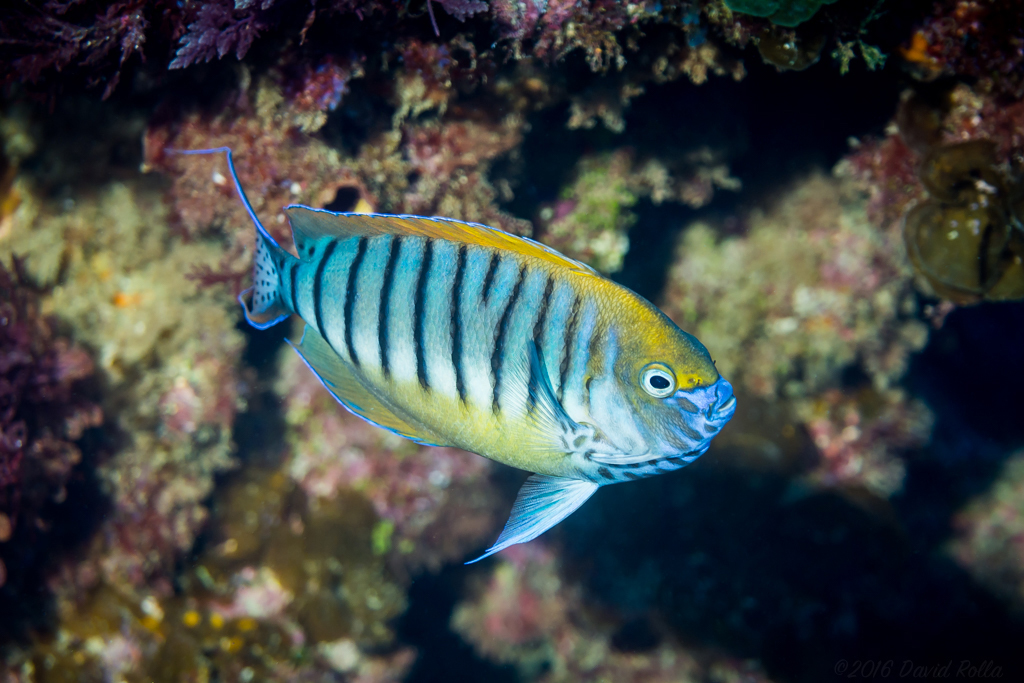- Classification
- ACTINOPTERYGII
- PERCIFORMES
- POMACANTHIDAE
- Genicanthus
- semicinctus
Halfbanded Angelfish, Genicanthus semicinctus Waite 1900
Other Names: Half-banded Angelfish

A male Halfbanded Angelfish, Genicanthus semicinctus, at Lord Howe Island in the Tasman Sea, November 2016. Source: David R / iNaturalist.org. License: CC BY Attribution-Noncommercial
Summary:
Males have fine black bars along the upper two-thirds of the body, with a yellowish-orange belly, a yellow dorsal fin and caudal-fin lobes, black spots on the breast and caudal fin. Females are dark grey above, whitish below, with dark caudal-fin lobes, narrow blue fin margins, and a black blotch above the eye enclosed by a bright blue ring.Males have filamentous caudal fin lobes.
This rare angelfish is only known from the Lord Howe Island region in the Tasman Sea, and the Kermadec Islands of northern new Zealand.
Video of Halfbanded Angelfish and a Ballina Angelfish, Chaetdontoplus ballinae, at South East Rock, Balls Pyramid near Lord Howe Island (40 sec into video).
Three videos of a male Halfbanded AngelFish in the wild: Video 1, Video 2, Video 3
This rare angelfish is only known from the Lord Howe Island region in the Tasman Sea, and the Kermadec Islands of northern new Zealand.
Video of Halfbanded Angelfish and a Ballina Angelfish, Chaetdontoplus ballinae, at South East Rock, Balls Pyramid near Lord Howe Island (40 sec into video).
Three videos of a male Halfbanded AngelFish in the wild: Video 1, Video 2, Video 3
Cite this page as:
Bray, D.J. 2021, Genicanthus semicinctus in Fishes of Australia, accessed 10 Jul 2025, https://fishesofaustralia.net.au/home/species/2504
Halfbanded Angelfish, Genicanthus semicinctus Waite 1900
More Info
|
Distribution |
Lord Howe Province in the Tasman Sea (Australia), and Raoul Island in the Kermadec Islands (northern New Zealand). Inhabits deep outer slopes on coral and rocky reefs at depths to 100 m, usually below 35 m. |
|
Biology |
Usually occurs in a small harem with a male and up to 4 females. If the male disappears, the dominant female will change sex and colour pattern over a period of several weeks. |
|
Remarks |
The Halfbanded Angelfish is reportedly fairly common at Balls Pyramid near Lord Howe Island. |
|
Etymology |
The specific name semicinctus is from the Latin semi- (= half) and cinctus (= belt, girdle), in reference to the narrow bands or bars along the upper two-thirds of the body in males. |
|
Species Citation |
Holacanthus semicinctus Waite, 1900, Rec. Aust. Mus. 3(7): 204, pl. 36. Type locality: Lord Howe Island. |
|
Author |
Bray, D.J. 2021 |
|
Resources |
Halfbanded Angelfish, Genicanthus semicinctus Waite 1900
References
Allen, G.R., Hoese, D.F., Paxton, J.R., Randall, J.E., Russell, B.C., Starck, W.A., Talbot, F.H. & Whitley, G.P. 1976. Annotated checklist of the fishes of Lord Howe Island. Records of the Australian Museum 30(15): 365-454 figs 1-2
Allen, G.R., Steene, R. & Allen, M. 1998. A Guide to Angelfishes & Butterflyfishes. Cairns : Odyssey Publishing/Tropical Reef Research 250 pp. figs.
Coleman, N. 1980. Australian Sea Fishes South of 30ºS. Lane Cove, NSW : Doubleday Australia Pty Ltd 309 pp.
Endoh, K. 2007. Angelfishes of the World. Two Little Fishies, Inc., Miami Gardens, Florida.
Francis, M. 1993. Checklist of the coastal fishes of Lord Howe, Norfolk, and Kermadec Islands, southwest Pacific Ocean. Pacific Science 47(2): 136-170 figs 1-2
Gill, A.C. & Reader, S.E. 1992. Fishes. pp. 90-93 in Hutchings, P. (ed.). Reef Biology. A Survey of Elizabeth and Middleton Reefs, South Pacific. Canberra : Australian National Parks Vol. 3, Kowari 230 pp.
Kuiter, R.H., Debelius, H. & Tanaka, H. 2003. Pomacanthidae, a Comprehensive Guide to Angelfishes. Melbourne : Zoonetics 206 pp.
Paulin, C., Stewart, A., Roberts, C. & McMillan, P. 1989. New Zealand fish: a complete guide. National Museum of New Zealand Miscellaneous Series 19: 1-279.
Pyle, R.L. 1997. A new angelfish of the genus Genicanthus (Perciformes: Pomacanthidae) from the Ogasawara Islands and Minami Tori Shima (Marcus Island). Revue française d'Aquariologie Herpétologie 24(3-4): 87-92.
Steene, R.C. 1978. Butterfly and Angelfishes of the World. Australia. Sydney : A.H. & A.W. Reed Vol. 1 144 pp. 216 figs.
Trnski, T. 2015. 188 Family Pomacanthidae (pp. 1306-1307), in Roberts, C.D., Stewart, A.L. & Struthers, C.D. (eds) The Fishes of New Zealand. Wellington : Te Papa Press Vol. 4 pp. 1153-1748.








